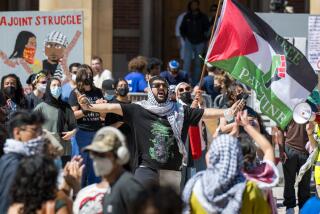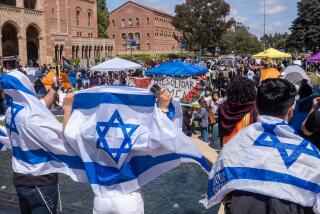Center Offers Sanctuary, Nurtures Many Faiths at UC Irvine Site
- Share via
IRVINE — On most Fridays when school is in session, a patchwork of tin-colored trailers on the UC Irvine campus serves as church, mosque and synagogue.
Around noon, the Roman Catholics put up portraits of Jesus and fashion a makeshift altar before a priest says Mass. An hour later, Jesus and the altar come down, and the Muslims take over.
They remove their shoes, roll out their prayer rugs and deliver the final call to prayer over a microphone hooked up to a small speaker at 1:15 p.m. Within an hour, the Muslims complete their services and make way for the Jews, who mark the Sabbath at sundown with prayers and dinner.
“Fridays are hectic,” said Father Patrick Philbin, after leading a Mass recently. “The Catholics barely have time to pack up and leave.”
Welcome to the Interfaith Center, the only ecumenical organization on any of the nine UC campuses. Founded primarily at the urging of UC Irvine’s first chancellor, Daniel Aldrich, the privately funded organization has steadily grown through three decades, despite blurring the lines between church and state.
“Dan felt very strongly that students should not only develop their minds and bodies, but also should have the space to explore their spirituality,” said Mabry Steinhaus, 82, the senior member of Interfaith’s board of directors.
The center is sanctuary to about 1,800 weekly visitors, representing 17 faiths including Protestants, Hindus, Buddhists and Bahais. In past years, it has also given shelter to Sikhs, Pagans for a Better Understanding and Hare Krishnas.
The center, tucked away in the university’s engineering complex, celebrated its 30th anniversary Saturday, with attendees using the occasion to rededicate themselves to the center’s main goals of fortifying faith and promoting respect for the world’s religions.
“Some people think we are silly trying to do what we do,” said Nancy Jenks, whose 20 years as the center’s executive director have earned her the nickname “The First Lady of Interfaith.” “But how does anyone expect we are going to get along in this world? It has to start somewhere.”
Interfaith began in 1966 inside a temporary trailer on the new campus of less than 1,600 students. A year later, the center moved across the street off campus, where for 14 years it shared a small building with other businesses in what is now Irvine Marketplace.
Impending commercial development drove the continually budget-strapped organization from its home. Unable to find affordable shelter within miles of campus, the board offered to purchase its own trailers on campus and donate them to the university. Further, Interfaith would pay all costs associated with operating the center.
Aldrich, the center’s chief backer and a longtime United Church of Christ member, agreed.
Since moving on campus in 1981, Interfaith has always struggled to survive financially. Every year, the center strains to raise the $50,000 needed to cover Jenks’ modest salary and maintenance, phone and electric bills.
UC officials did not return phone calls to discuss the center’s presence on campus, though as a public university, UC has a policy calling for the separation of church and state and avoiding the appearance of sanctioning religious organizations. UC Irvine officials also would not comment on the matter, offering only a faxed copy of university policy regarding church and state.
The policy says in part: “As a state instrumentality, the university must remain neutral on religious and political matters. The university cannot sponsor or fund religious activities.”
But since relocating to the campus, Interfaith has drawn few, if any, protests and has enjoyed the tacit approval of the university’s administration.
Through the decades, Interfaith has quietly built on its mission to foster religious understanding by expanding upon the ordinary and extraordinary events of life. One of the center’s longest-standing traditions is a Thursday lunch for people of various races and religions.
Dat Trinh, a UC Irvine senior who was raised a Buddhist but is considering converting to Catholicism, was among 25 students sharing conversation at a recent lunch.
“I’m still in the discovery stage,” said Trinh, 22. “The point of every religion is to be a good person, but Catholicism seems to offer a more personal relationship with God, which is important to me.”
Besides trying to enrich a student’s everyday life, Interfaith has opened its doors during times of intense grief and anger. When the space shuttle exploded in 1986, the center sponsored a memorial service that drew hundreds of students, Christian, Jews and Muslims alike.
In November, more than 50 students turned out for a service after the assassination of Israeli Prime Minister Yitzhak Rabin. Catholic and Episcopalian groups brought flowers to the ceremony, where the Jewish prayer for the dead was read in Hebrew and English.
While priding itself on tolerance, the Interfaith Center has found its own commitment to diversity tested on occasions. About seven years ago, a group of fewer than 10 students calling themselves Pagans for a Better Understanding wanted access to the center.
Many, including the center’s board of directors, balked at admitting them, but Jenks argued that banning the group would violate the spirit of Interfaith. She won. The pagans, however, won few converts and disbanded a couple years ago.
Interfaith has also clashed with a few fundamentalist Christian groups that officials say insisted on proselytizing--even in the center.
“You can’t be in a facility like this where we are working together and come in and try to ‘convert the heathens,’ ” said Jenks, a former Baptist turned Presbyterian. “We don’t allow that to happen here.”
For the religious students, the Interfaith Center has been an invaluable part of campus life and education.
This is especially true for small groups like the Muslims, who are a tiny minority on the predominantly secular and Christian campus. “We are very lucky,” said Abdel Ahmed, 31, an Egyptian and doctoral student in mechanical engineering. “I was worried when I came here whether I could find a mosque at all.”
Other students find it a uniquely relaxed forum in which to reexamine their own faith.
“If everyone around you believes like you do, then you are never going to be challenged,” said Linh Le, 23, a biology and studio art major who is Catholic. “And without challenge, there is no growth.”
More to Read
Sign up for Essential California
The most important California stories and recommendations in your inbox every morning.
You may occasionally receive promotional content from the Los Angeles Times.










